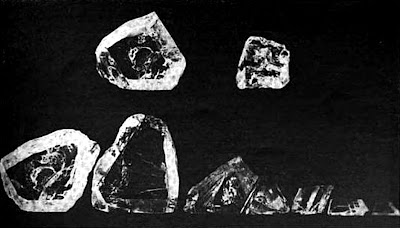January 25, 1905, at the Premier Mine in Pretoria, South Africa, a 3,106-carat diamond is discovered. Weighing 1.33 pound it was the largest diamond ever found and was the largest polished diamond in the world until the 1985 discovery of the Golden Jubilee Diamond, 545.67 carats, also from the Premier Mine.
Cullinan I is now mounted in the head of the Sceptre with the Cross. The second largest gem from the Cullinan stone, Cullinan II or the Lesser Star of Africa, at 317.4 carats, is the fourth largest polished diamond in the world. Both gems are in the Crown Jewels of the United Kingdom.
The Premier Diamond Mine in South Africa where the Cullinan was found was comparatively new, having only been worked since 1902. It had, however, already produced over $25,000,000 worth 'of the precious stones, and its size is so enormous that it was feared by other diamond mine owners that the output of the Premier in the future will seriously affect the diamond market. This great mine as yet has only been worked on the surface, and when it is considered that it can be worked for thousands of feet deep its estimated value is beyond man's comprehension.
In its rough state the Cullinan was irregular in shape, and it was without doubt only part of a much larger stone, for there were indisputable evidences that on three sides large pieces had been broken off. In fact, by many of the experts who handled it it is believed that it was only a small piece of a very much larger stone, but there was less possibility of reconstructing it than to reconstruct the statue of Venus de Milo. Perhaps, however, the mystery may some day be solved by the other pieces of the stone being found.
In recent years when large stones were discovered it has been a problem as to what disposition should be made of them. This was notably so in the case of the Jubilee and the Excelsior, but when the Cullinan was discovered the problem was further complicated for it was out of the question that any individual buyer could be found for it, as its value in the rough was three-quarters of a million dollars— in other words the stone was priceless.
Of course it could have been broken up into marketable size pieces but such a course would have greatly diminished its value; and so pending a decision of the best adjustment to te made of it the diamond as large as a tumbler was sent to London to repose in the vaults of the Rough Syndicate for safe keeping. Then the Transvaal government conceived a happy thought of presenting the gem to King Edward, and so the historic pebble becomes the property of the Crown of England.
After the decision was reached to present the King with the diamond the serious question arose as to the manner in which it should be cut and polished, for an unpolished stone to the unpracticed eye has about the same luster as a piece of camphor. With this end in view the great diamond firm of J. Asscher, of Amsterdam and Paris, was brought into requisition.
This firm was originally started by the father of the present manager, who descended from a long line of diamond workers. This diamond factory is the largest of its kind in the world, and surely the best adapted to have undertaken such a complicated and intricate work as the cleaving and polishing of a diamond such as the Cullman. The stone was consequently turned over to the Asschers to do with it as their good judgment might dictate. After the diaimond was received at the factory it.was photographed in all possible positions.
This Image (or other media file) is in the public domain because its copyright has expired. This applies to the United States, where Works published prior to 1978 were copyright protected for a maximum of 75 years. See Circular 1 "COPYRIGHT BASICS" PDF from the U.S. Copyright Office. Works published before 1923 in this case 1904, are now in the public domain.
TEXT and IMAGE CREDIT: Technical world magazine, Volume 11 Author: Armour Institute of Technology. Publisher: American school of correspondence at Armour Institute of Technology, 1909. Original from: the University of Michigan. Digitized: Dec 12, 2008. Subjects: Technology & Engineering › General Industrial arts, Technology, Technology & Engineering / General Technology & Engineering / Social Aspects.
TEXT RESOURCE: Cullinan Diamond From Wikipedia



No comments:
Post a Comment